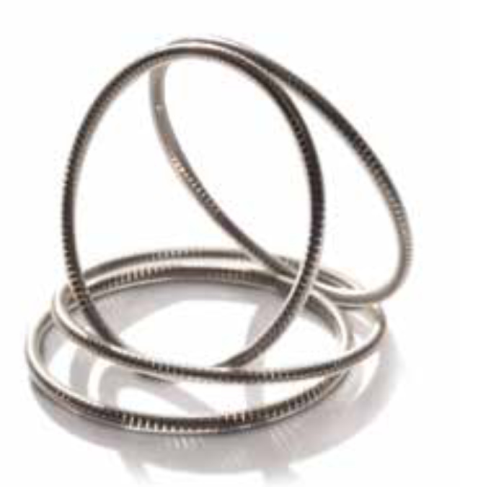FEP-encapsulated helical spring O-rings, a testament to engineering resilience, are redefining what engineers can expect from cryogenic sealing in space environments.
In aerospace and launch systems, where seals must endure everything from deep vacuum to cryogenic propellants, failure is not an option. Traditional elastomeric seals become brittle and unreliable at the extremely low temperatures encountered in space missions. As a result, engineers require sealing solutions that combine resilience, chemical resistance, and consistent performance under punishing conditions.
This article explores why FEP-encapsulated helical spring O-rings have become a trusted sealing solution in cryogenic aerospace systems. We’ll examine the challenges of sealing in space, the features that make these O-rings ideal for such environments, and where they are being successfully deployed in today’s launch vehicles and propulsion systems.
The Challenge of Cryogenic Sealing in Space
The unique conditions of spaceflight, including exposure to cryogenic fluids such as liquid oxygen (LOX), liquid methane, and liquid hydrogen, present a set of stresses that would compromise or destroy traditional seals. These fuels are stored and transported at temperatures approaching -420°F (-250°C), far beyond the performance limits of most elastomer-based seals.
In addition to cryogenic exposure, seals in launch vehicles must contend with extreme pressure variations, from storage tanks at 100 psi to turbopump outlets exceeding 15,000 psi; thermal shock, when materials are rapidly heated and cooled during startup and shutdown; vacuum conditions, which amplify outgassing and increase the risk of material degradation; and supercritical fluid handling, where fluids behave as both gas and liquid while demanding perfect sealing to avoid leakage or combustion risks
In such conditions, even minor leakage can result in fuel loss, combustion instability, or total system failure. Elastomeric seals, regardless of their chemical resistance, will become brittle and prone to cracking under such extreme cold. Additionally, traditional O-rings can suffer from compression set, losing their sealing force after only a few cycles of use.
Why FEP-Encapsulated Helical Spring O-Rings Work
FEP-encapsulated helical spring O-rings are designed for use in the hostile environments of space. Each seal consists of a stainless steel flat-wound helical spring core, typically made from 302 stainless steel, completely encapsulated in a seamless FEP (fluorinated ethylene propylene) jacket. This design marries the best of both worlds: a chemically inert outer surface and a mechanically resilient inner spring.
Benefits of the FEP Jacket
The FEP jacket brings several benefits:
- Cryogenic durability: FEP maintains flexibility and integrity at ultra-low temperatures
- Chemical resistance: Inert to LOX, liquid methane, hydrogen, and most aerospace-grade fluids
- Non-stick surface: Minimizes friction and reduces the risk of contamination or particulate generation
- Low permeability: Offers excellent barrier properties in vacuum and supercritical conditions
Benefits of the Helical Spring Core
The helical core adds to that with its own special (and critical) features:
- Consistent sealing force: The spring applies uniform pressure, compensating for material deformation or wear
- Resistance to compression set: Unlike elastomers, the spring does not relax or lose force over time
- Temperature resilience: Maintains performance across broad thermal swings—from cryogenic fill to engine ignition
The result is a sealing solution that withstands cryogenic storage tanks, turbopump manifolds, and LOX feed systems, delivering predictable and repeatable performance, even after multiple thermal cycles.

FEP-Encapsulated Helical Spring O-Rings for Aerospace and Rocket Systems
The value of FEP-encapsulated helical spring O-rings becomes clear when examining their deployment in real-world space systems. These seals are frequently found in:
- Cryogenic valve assemblies, where they prevent leakage at pipe junctions, manifolds, and fill ports
- Turbopump flanges and housings, which handle rapid pressure increases and thermal fluctuations
- Fuel and oxidizer feed lines, including stage separation and preburner systems
- Supercritical fluid interfaces, where precise sealing is critical for performance and safety
Their use is particularly valuable in systems that transport or isolate LOX, LH2, or RP-1 (refined kerosene) in Kero-Lox and Metha-Lox configurations. In these systems, preventing cross-contamination between oxidizers and fuels is crucial, as premature mixing can lead to instantaneous ignition or explosion.
Additionally, FEP-encapsulated designs align with the industry’s push toward lightweight and low-maintenance components. Because they do not require lubrication and offer long service life, they reduce mass and complexity in the vehicle’s overall sealing strategy.
Conclusion
Sealing in space is not a job for off-the-shelf elastomers. It demands materials and designs that can withstand vacuum, cryogenics, pressure spikes, and chemically aggressive media without losing integrity. These O-rings meet these requirements and then some.
The combination of a chemically resistant FEP jacket and a load-maintaining helical spring core in these O-rings makes them ideal for aerospace systems where performance and reliability are non-negotiable. Whether you’re designing for LOX manifolds, liquid hydrogen feed lines, or cryogenic stage separation, these seals deliver the peace of mind that only proven engineering can provide.
For custom-engineered helical spring O-rings designed to thrive in spaceflight conditions, contact Advanced EMC Technologies. Our team has the experience, materials, and manufacturing capabilities to deliver high-performance sealing solutions for the most extreme environments in the universe.


